Ground-Based Oblique-View Photogrammetry and Sentinel-1 Spaceborne RADAR Reflectivity Snow Melt Processes Assessment on an Arctic Glacier
Abstract
1. Introduction
2. Materials and Methods
2.1. Ground-Based Oblique-View Photograph Processing
- Reaching higher ground leads to greater chances of the camera being shielded by clouds from taking pictures of the glacier (Appendix A).
- The area observed by a single camera is limited to the glacier snout and will hence only provide reference observations for the early melt season.
- Ground-based imaging remains more favorable than spaceborne imaging because under most circumstances the cameras are below clouds even when the satellite is prevented from observing the glacier basin, but oblique-view imaging requires azimuthal projection post-processing and some areas of the glaciers are hidden below the curvature of the ice surface.
2.2. Spaceborne RADAR Signal Collection and Processing
- Split for selecting one or two bursts covering the Brøgger peninsula in a single subswath, both parameters having been identified for each possible orbital track with the SNAP graphical user interface;
- Seamless integration of successive RADAR bursts in case more than a single burst was selected (deburst function);
- Range-Doppler Terrain correction for projecting the dataset on an external Digital Elevation Model (DEM), in our case the 5 m DEM provided by Norwegian Polar Institute at https://data.npolar.no/dataset/dce53a47-c726-4845-85c3-a65b46fe2fea (accessed on 20 March 2023) and producing a UTM 33N projected map readily inserted in QGIS. From this analysis, we focus on the HH polarization because the HV is observed to hardly provide any information on the snow cover of the glacier.
2.3. Spaceborne Multispectral Image Collection
3. Results and Analysis
- Initially, at the end of the winter, the bright snow appears as a strongly reflective homogeneous layer at optical wavelengths and the dry snow allows for the microwave penetration to the ice surface and its reflection back to the RADAR receiver, displaying a strong microwave reflectivity.
- As the temperature rises above the snow melting point, the snowpack fills with liquid water but remains optically bright with a strong albedo. The microwave is however attenuated by the water and is no longer reflected by the snow–ice interface: while the glacier remains with a high albedo at optical wavelengths, it suddenly becomes dark at microwave wavelengths with the whole snowpack saturated with water. Only the upper part of the glacier remains bright for a short duration as the heat wave rises, inducing the snow melt and high water content of the snowpack.
- As the melt season starts, the snowpack both melts and is carried away by flowing water. While optical imaging shows the snowpack recess with exposed dark ice observed as low multispectral reflectivity regions, the microwave remains absorbed by a water-soaked snowpack and water running over the ice close to the FSC. Hence, the low microwave reflectivity region extends over areas that are identified optically as below the ice–snow limit, either due to the water-soaked snowpack appearing dark optically or running water on the surface of the ice as the snow melts and only dry ice well below the ice–snow limit appears as a bright microwave reflecting surface.
- Once the whole snowpack has melted at the end of the melt season, the glacier appears again as a bright microwave reflector as its surface has dried and no longer absorbs the microwaves, while optical and infrared imaging observe the bare ice surface as a lower albedo surface than the initial snow-covered surface.
- On the left column, from top to bottom: On 17 May (VV polarization) or 13 May (HH polarization), the RADAR map hints at a dry snow cover reflecting the microwave signal, with blue meaning strong reflectivity, whereas the spaceborne and ground-based pictures indicate a fully white homogeneous snow cover. All the 2017 Sentinel-1 acquisitions are collected in horizontal (H) polarization while the 2019 acquisitions provide both horizontal and vertical (V) polarized illumination. Nevertheless, little difference is observed between H and V as long as the copolarization reflectivity maps are analyzed.
- On the middle column, from top to bottom: On 10 June (VV polarization) or 6 June (HH polarization), the RADAR imaging observes a wet glacier snout, with red meaning low reflectivity, because the microwave is absorbed by the wet snow, while the upper part of the glacier remains dry, but the optical spaceborne and ground-based camera images remain homogeneously white. The only hint of melt in the ground-based camera is the avalanche highlighted by the yellow arrows (bottom).
- On the right column, from top to bottom: On 16 June (VV polarization) or 18 June (HH polarization), the whole snowpack is saturated with water following the warm period (positive temperatures), with a strong microwave attenuation over the whole glacier appearing as red, and yet the optical images collected by Sentinel-2 still remain fully white. Clues of snowpack humidification on the Sentinel-2 image are hinted, with the snow swamps and supraglacial lake formation highlighted as red rectangles and the supraglacial lake (bottom right) and outflows (three upper rectangles) magnified. The ground-based optical image still displays a fully white snow cover except for the wet, loose snow avalanche (yellow arrows on the bottom ground-based picture).
4. Conclusions
Author Contributions
Funding
Conflicts of Interest
Appendix A

References
- Bavay, M.; Grünewald, T.; Lehning, M. Response of snow cover and runoff to climate change in high Alpine catchments of Eastern Switzerland. Adv. Water Resour. 2013, 55, 4–16. [Google Scholar] [CrossRef]
- Hock, R. A distributed temperature-index ice-and snowmelt model including potential direct solar radiation. J. Glaciol. 1999, 45, 101–111. [Google Scholar] [CrossRef]
- Sobota, I.; Weckwerth, P.; Grajewski, T. Rain-On-Snow (ROS) events and their relations to snowpack and ice layer changes on small glaciers in Svalbard, the high Arctic. J. Hydrol. 2020, 590, 125279. [Google Scholar] [CrossRef]
- Theakstone, W. Changes of snow cover thickness measured by conventional mass balance methods and by global positioning system surveying. Ann. Ser. 1999, 81, 767–776. [Google Scholar] [CrossRef]
- Eckerstorfer, M.; Christiansen, H.H. The “High Arctic Maritime Snow Climate” in Central Svalbard. Arctic Antarct. Alp. Res. 2011, 43, 11–21. [Google Scholar] [CrossRef]
- Bruland, O.; Sand, K. Snow Distribution at a High Arctic Site at Svalbard. Nord. Hydrol. 2001, 32, 1–12. [Google Scholar] [CrossRef]
- Verbunt, M.; Gurtz, J.; Jasper, K.; Lang, H.; Warmerdam, P.; Zappa, M. The hydrological role of snow and glaciers in alpine river basins and their distributed modeling. J. Hydrol. 2003, 282, 36–55. [Google Scholar] [CrossRef]
- Debeer, C.M.; Pomeroy, J.W. Modelling snow melt and snowcover depletion in a small alpine cirque, Canadian Rocky Mountains. Hydrol. Process. 2009, 2599, 2584–2599. [Google Scholar] [CrossRef]
- Mott, R.; Lehning, M.; Owe, H.L.; Hynek, B.; Michlmayer, G.; Prokop, A.; Oner, W.S.C.H. Simulation of seasonal snow-cover distribution for glacierized sites on Sonnblick, Austria, with the Alpine3D model. Ann. Glaciol. 2008, 2, 155–160. [Google Scholar] [CrossRef]
- Hodgkins, R. Glacier hydrology in Svalbard, Norwegian High Arctic. Quat. Sci. Rev. 1997, 16, 957–973. [Google Scholar] [CrossRef]
- Shepherd, A.; Hubbard, A.; Nienow, P.; King, M.; McMillan, M.; Joughin, I. Greenland ice sheet motion coupled with daily melting in late summer. Geophys. Res. Lett. 2009, 36, L01501. [Google Scholar] [CrossRef]
- Liu, J.; Chen, R.; Ding, Y.; Han, C.; Ma, S. Snow process monitoring using time-lapse structure-from-motion photogrammetry with a single camera. Cold Reg. Sci. Technol. 2021, 190, 103355. [Google Scholar] [CrossRef]
- Rippin, D. High Resolution Mapping of the Cold/Temperate Transition Surface of the Polythermal Glaciers Midre Lovénbreen and Austre Lovénbreen, Svalbard (NERC). 1999, pp. 1–6. Available online: gef.nerc.ac.uk (accessed on 20 March 2023).
- Bernard, E.; Friedt, J.; Schiavone, S.; Tolle, F.; Griselin, M. Assessment of periglacial response to increased runoff: An Arctic hydrosystem bears witness. Land Degrad. Dev. 2018, 29, 3709–3720. [Google Scholar] [CrossRef]
- Kirkbride, M.P.; Winkler, S. Correlation of Late Quaternary moraines: Impact of climate variability, glacier response, and chronological resolution. Quat. Sci. Rev. 2012, 46, 1–29. [Google Scholar] [CrossRef]
- Hagen, J.O.; Lefauconnier, B. Reconstructed Runoff from the High Arctic Basin Bayelva based on Mass-Balance Measurements. Nord. Hydrol. 1995, 26, 285–296. [Google Scholar] [CrossRef]
- Svendsen, H.; Beszczynska-Møller, A.; Hagen, J.O.; Lefauconnier, B.; Tverberg, V.; Gerland, S.; Ørbøk, J.B.; Bischof, K.; Papucci, C.; Zajaczkowski, M.; et al. The physical environment of Kongsfjorden–Krossfjorden, an Arctic fjord system in Svalbard. Polar Res. 2002, 21, 133–166. [Google Scholar] [CrossRef]
- Førland, E.J.; Benestad, R.; Hanssen-Bauer, I.; Haugen, J.E.; Skaugen, T.E. Temperature and Precipitation Development at Svalbard 1900–2100. Adv. Meteorol. 2011, 2011, 893790. [Google Scholar] [CrossRef]
- Hodgkins, R.; Cooper, R.; Wadham, J.; Tranter, M. The hydrology of the proglacial zone of a high-Arctic glacier (Finsterwalderbreen, Svalbard): Atmospheric and surface water fluxes. J. Hydrol. 2009, 378, 150–160. [Google Scholar] [CrossRef]
- Nuth, C.; Moholdt, G.; Kohler, J.; Hagen, J.O.; Kääb, A. Svalbard glacier elevation changes and contribution to sea level rise. J. Geophys. Res. Earth Surf. 2010, 115, F01008. [Google Scholar] [CrossRef]
- Moholdt, G.; Hagen, J.; Eiken, T.; Schuler, T. Geometric changes and mass balance of the Austfonna ice cap, Svalbard. Cryosphere 2010, 4, 21–34. [Google Scholar] [CrossRef]
- Christiansen, H.; Humlum, O.; Eckerstorfer, M. Central svalbard 2000–2011 meteorological dynamics and periglacial landscape response. Arctic Antarct. Alp. Res. 2013, 45, 6–18. [Google Scholar] [CrossRef]
- Rutter, N.; Hodson, A.; Irvine-Fynn, T.; Solås, M.K. Hydrology and hydrochemistry of a deglaciating high-Arctic catchment, Svalbard. J. Hydrol. 2011, 410, 39–50. [Google Scholar] [CrossRef]
- Marin, C.; Bertoldi, G.; Premier, V.; Callegari, M.; Brida, C.; Hürkamp, K.; Tschiersch, J.; Zebisch, M.; Notarnicola, C. Use of Sentinel-1 radar observations to evaluate snowmelt dynamics in alpine regions. Cryosphere 2020, 14, 935–956. [Google Scholar] [CrossRef]
- Barella, R.; Callegari, M.; Marin, C.; Klug, C.; Sailer, R.; Galos, S.; Dinale, R.; Gianinetto, M.; Notarnicola, C. Combined Use of Sentinel-1 and Sentinel-2 for Glacier Mapping: An Application over Central East Alps. IEEE J. Sel. Top. Appl. Earth Obs. Remote Sens. 2022, 15, 4824–4834. [Google Scholar] [CrossRef]
- Lievens, H.; Brangers, I.; Marshall, H.P.; Jonas, T.; Olefs, M.; De Lannoy, G. Sentinel-1 snow depth retrieval at sub-kilometer resolution over the European Alps. Cryosphere 2022, 16, 159–177. [Google Scholar] [CrossRef]
- Bernard, É.; Friedt, J.M.; Tolle, F.; Griselin, M.; Martin, G.; Laffly, D.; Marlin, C. Monitoring seasonal snow dynamics using ground based high resolution photography (Austre Lovénbreen, Svalbard, 79 N). ISPRS J. Photogramm. Remote Sens. 2013, 75, 92–100. [Google Scholar] [CrossRef]
- Koskinen, J.; Metsämäki, S.; Grandell, J.; Jänne, S.; Matikainen, L.; Hallikainen, M. Snow monitoring using radar and optical satellite data. Remote Sens. Environ. 1999, 69, 16–29. [Google Scholar] [CrossRef]
- Salcedo, A.P.; Cogliati, M.G. Snow cover area estimation using Radar and optical satellite information. Atmos. Clim. Sci. 2014, 4, 514–523. [Google Scholar] [CrossRef]
- Storvold, R.; Malnes, E.; Lauknes, I. Using ENVISAT ASAR wideswath data to retrieve snow covered area in mountainous regions. EARSeL eProc. 2005, 4, 150–156. [Google Scholar]
- Karbou, F.; Veyssière, G.; Coleou, C.; Dufour, A.; Gouttevin, I.; Durand, P.; Gascoin, S.; Grizonnet, M. Monitoring wet snow over an alpine region using Sentinel-1 observations. Remote Sens. 2021, 13, 381. [Google Scholar] [CrossRef]
- Winsvold, S.H.; Kääb, A.; Nuth, C.; Andreassen, L.M.; Van Pelt, W.J.; Schellenberger, T. Using SAR satellite data time series for regional glacier mapping. Cryosphere 2018, 12, 867–890. [Google Scholar] [CrossRef]
- Buchelt, S.; Skov, K.; Rasmussen, K.K.; Ullmann, T. Sentinel-1 time series for mapping snow cover depletion and timing of snowmelt in Arctic periglacial environments: Case study from Zackenberg and Kobbefjord, Greenland. Cryosphere 2022, 16, 625–646. [Google Scholar] [CrossRef]
- Gascoin, S.; Barrou Dumont, Z.; Deschamps-Berger, C.; Marti, F.; Salgues, G.; López-Moreno, J.I.; Revuelto, J.; Michon, T.; Schattan, P.; Hagolle, O. Estimating fractional snow cover in open terrain from Sentinel-2 using the normalized difference snow index. Remote Sens. 2020, 12, 2904. [Google Scholar] [CrossRef]
- Bozzini, C.; Conedera, M.; Krebs, P. A new monoplotting tool to extract georeferenced vector data and orthorectified raster data from oblique non-metric photographs. Int. J. Herit. Digit. Era 2012, 1, 499–518. [Google Scholar] [CrossRef]
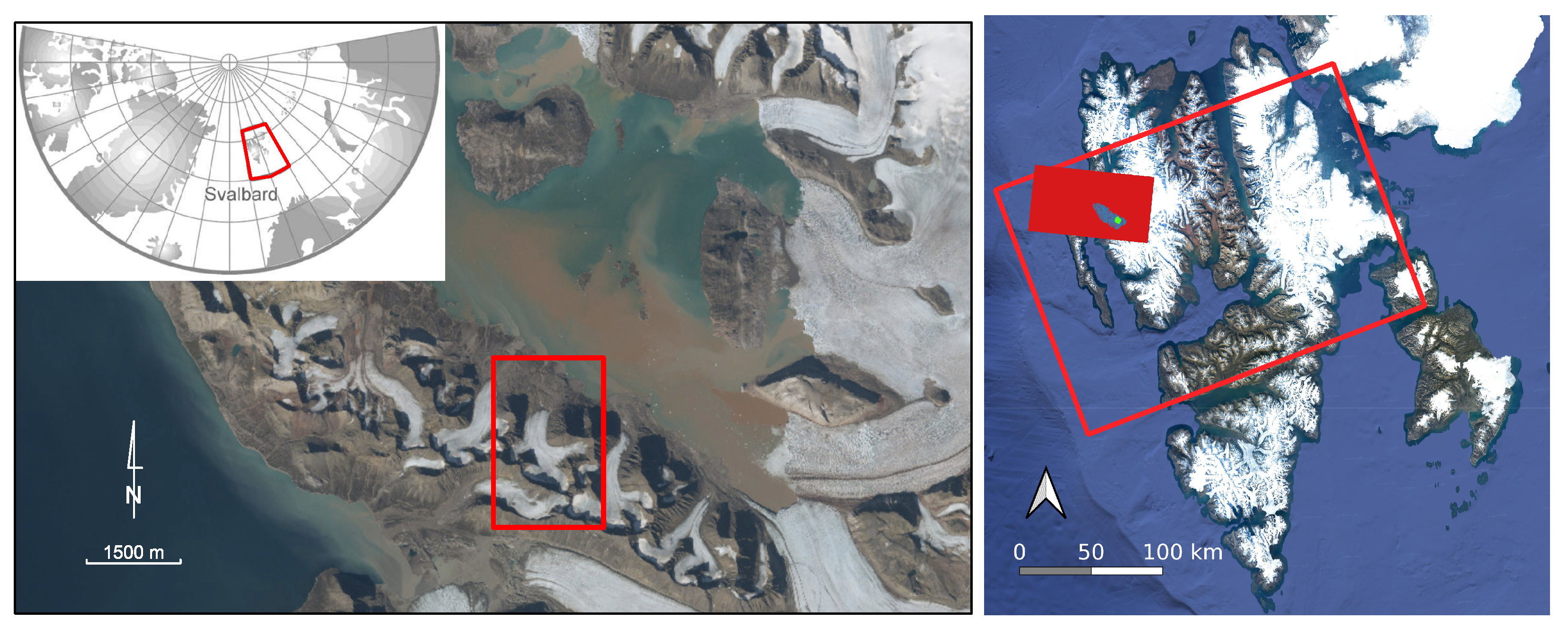

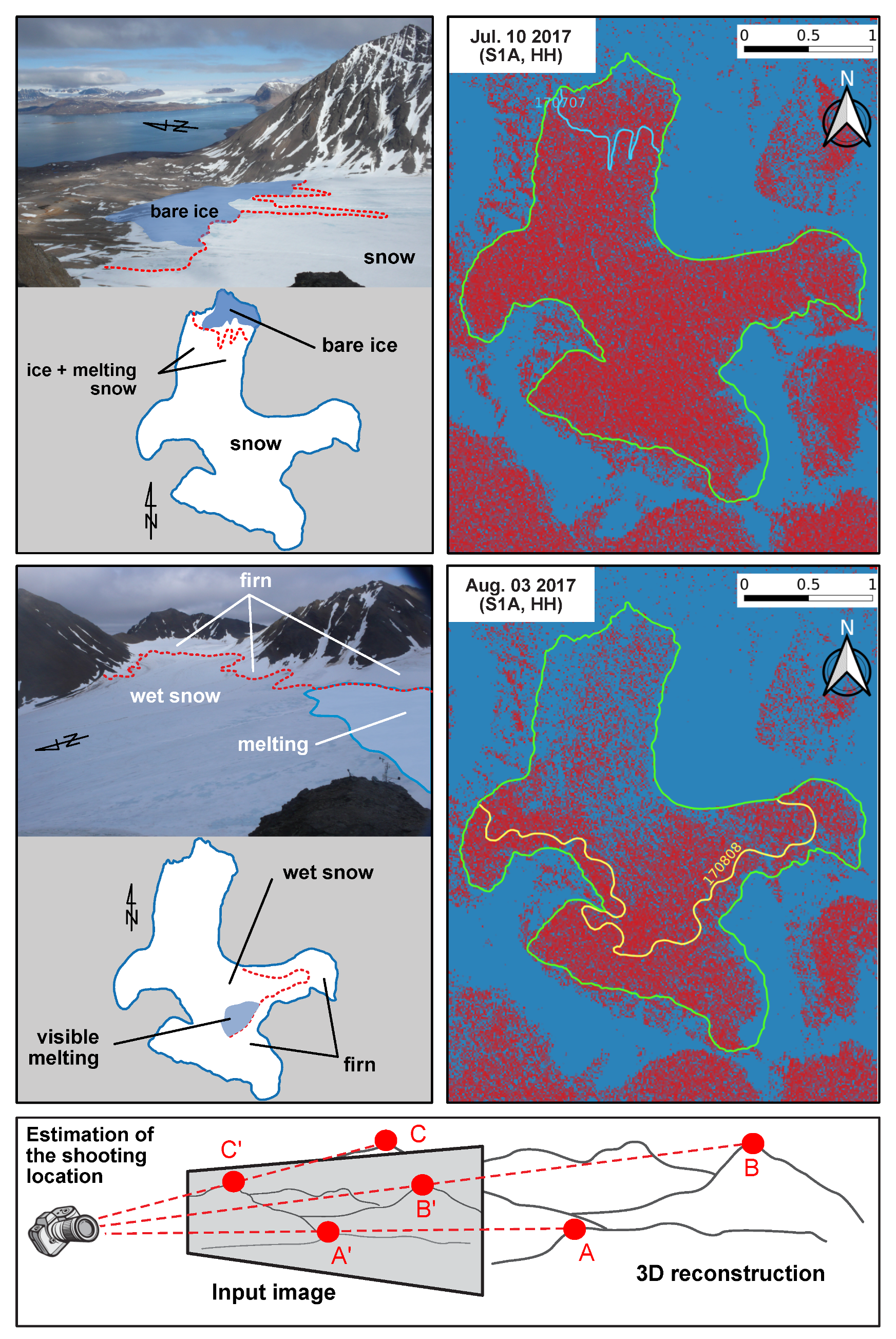
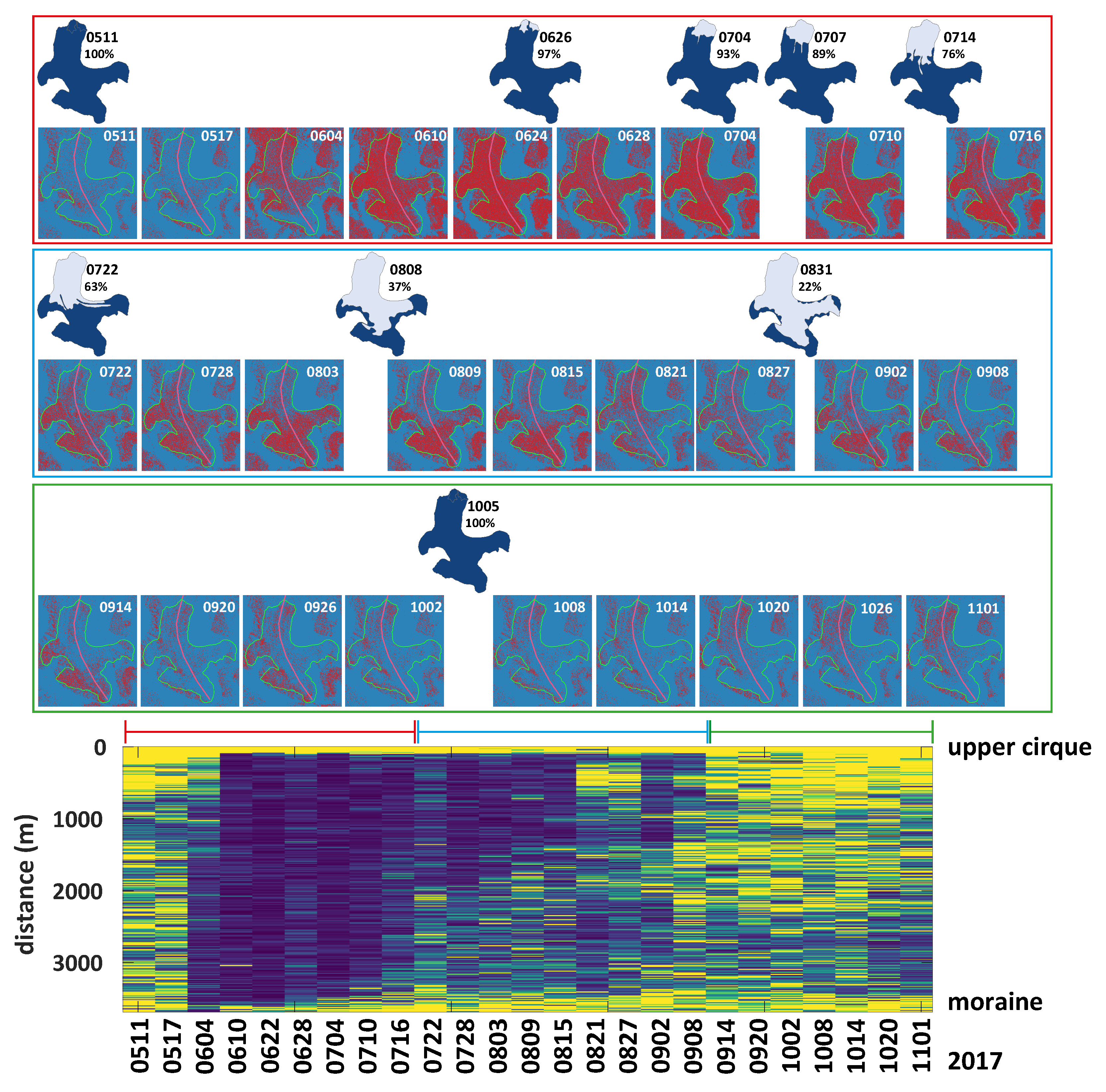
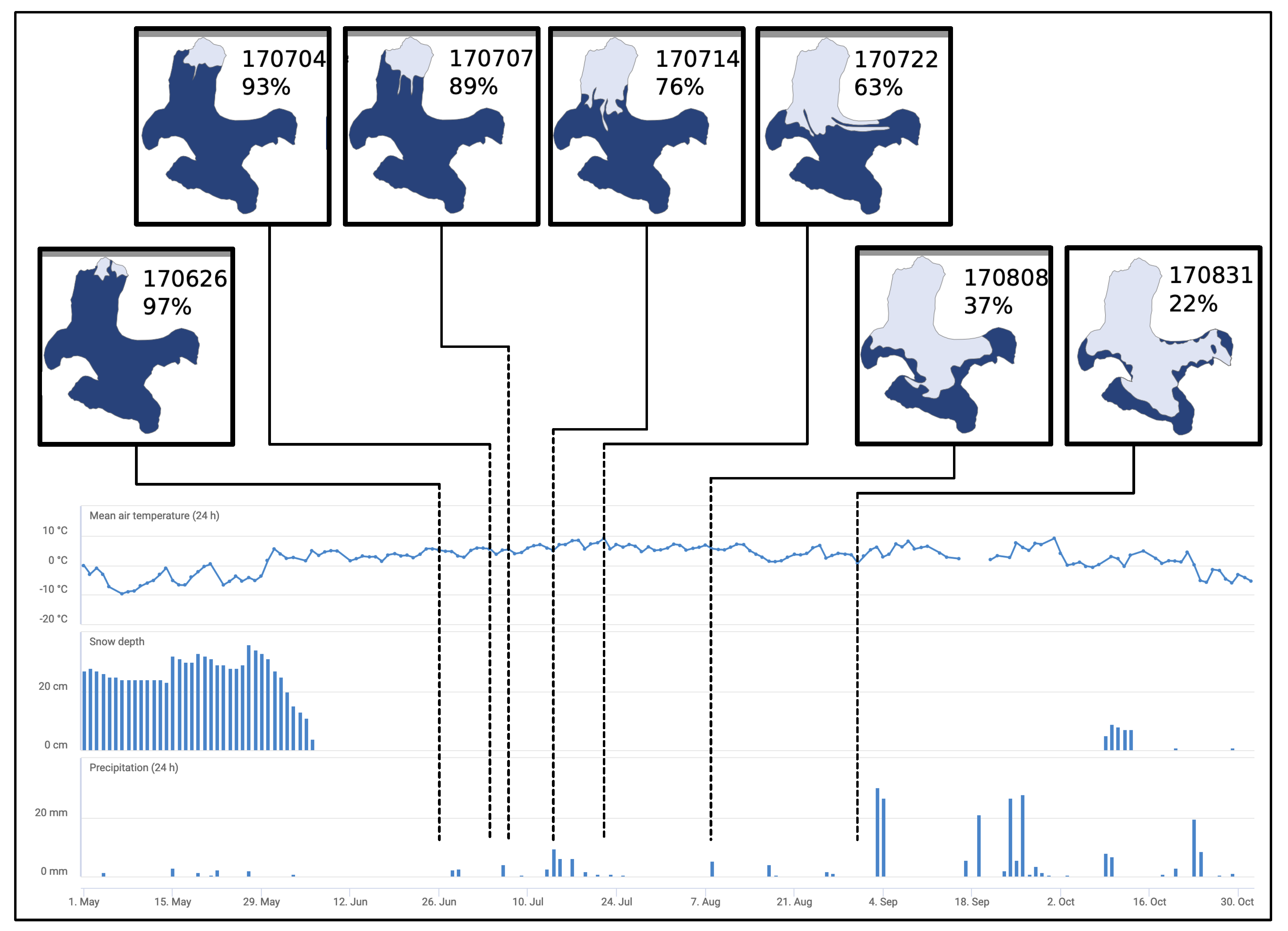

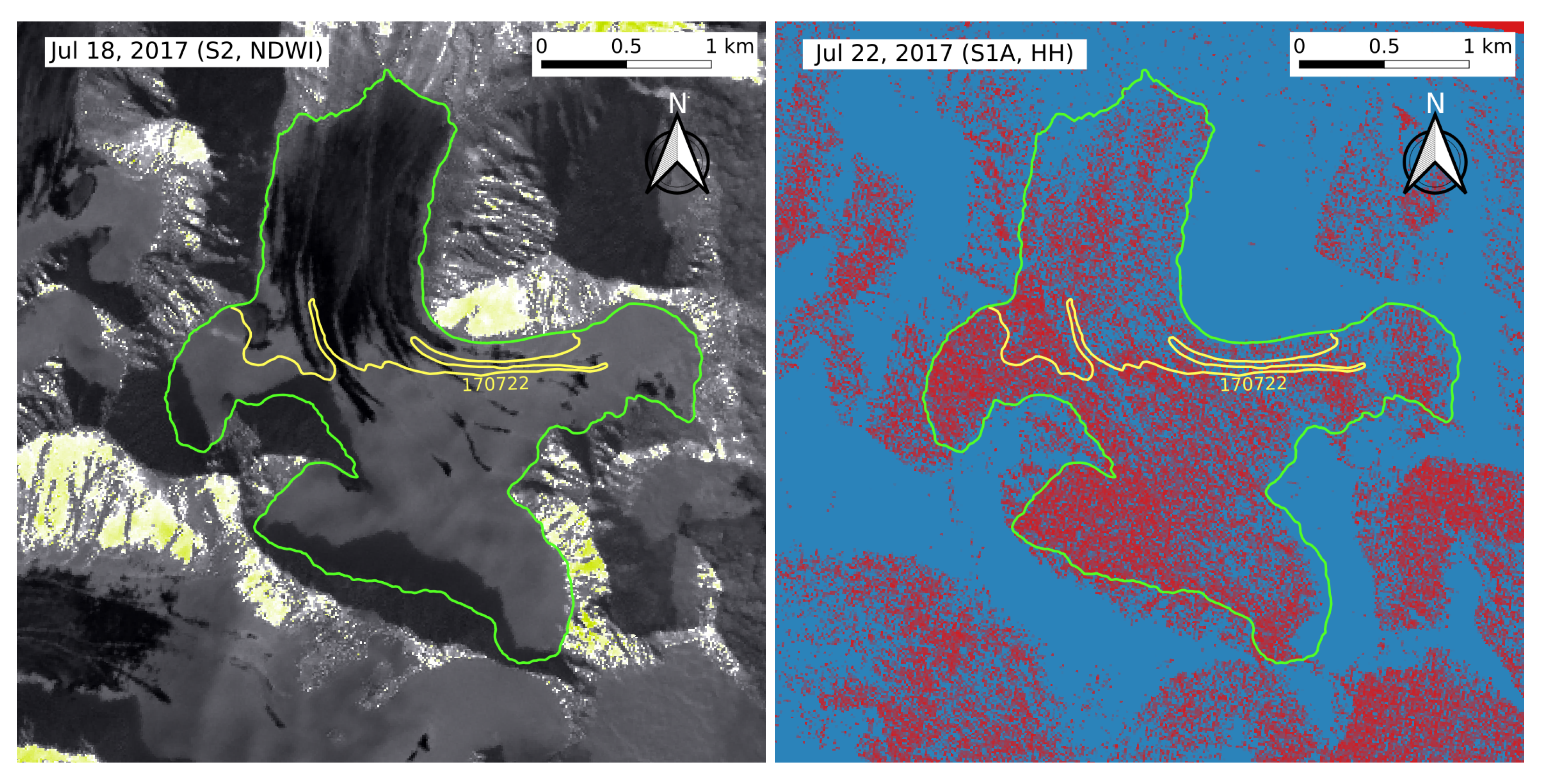


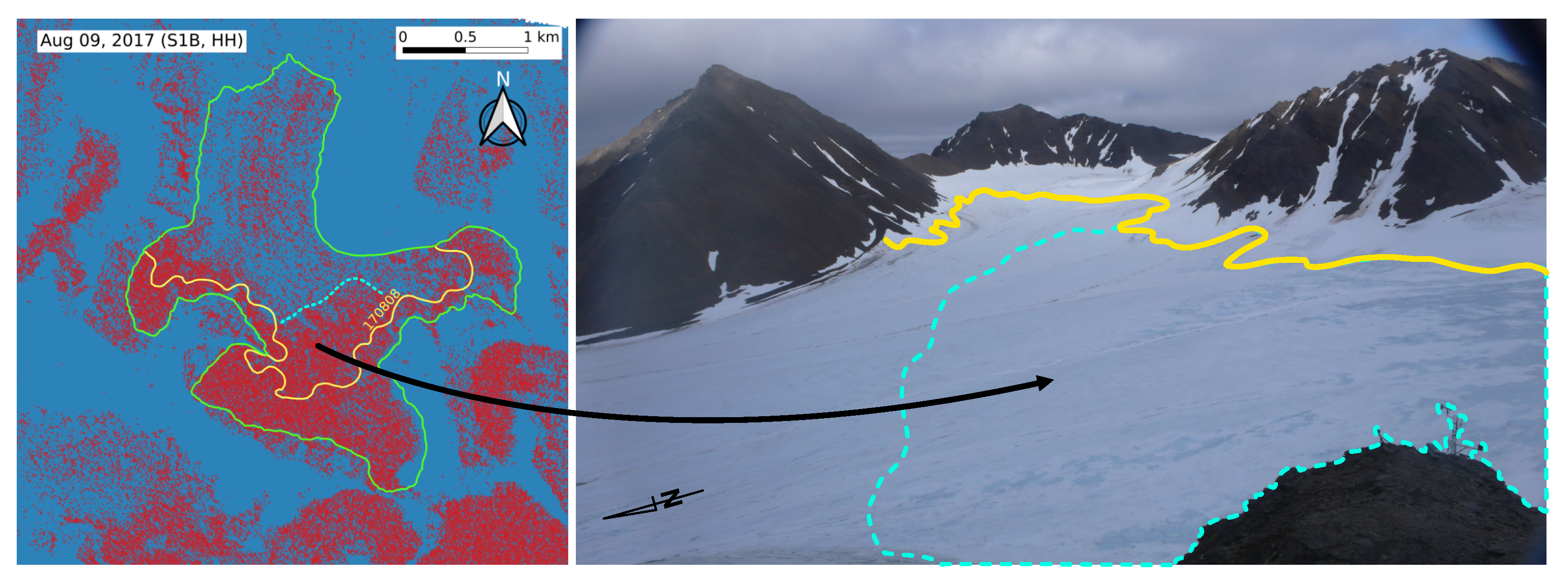
Disclaimer/Publisher’s Note: The statements, opinions and data contained in all publications are solely those of the individual author(s) and contributor(s) and not of MDPI and/or the editor(s). MDPI and/or the editor(s) disclaim responsibility for any injury to people or property resulting from any ideas, methods, instructions or products referred to in the content. |
© 2023 by the authors. Licensee MDPI, Basel, Switzerland. This article is an open access article distributed under the terms and conditions of the Creative Commons Attribution (CC BY) license (https://creativecommons.org/licenses/by/4.0/).
Share and Cite
Friedt, J.-M.; Bernard, É.; Griselin, M. Ground-Based Oblique-View Photogrammetry and Sentinel-1 Spaceborne RADAR Reflectivity Snow Melt Processes Assessment on an Arctic Glacier. Remote Sens. 2023, 15, 1858. https://doi.org/10.3390/rs15071858
Friedt J-M, Bernard É, Griselin M. Ground-Based Oblique-View Photogrammetry and Sentinel-1 Spaceborne RADAR Reflectivity Snow Melt Processes Assessment on an Arctic Glacier. Remote Sensing. 2023; 15(7):1858. https://doi.org/10.3390/rs15071858
Chicago/Turabian StyleFriedt, Jean-Michel, Éric Bernard, and Madeleine Griselin. 2023. "Ground-Based Oblique-View Photogrammetry and Sentinel-1 Spaceborne RADAR Reflectivity Snow Melt Processes Assessment on an Arctic Glacier" Remote Sensing 15, no. 7: 1858. https://doi.org/10.3390/rs15071858
APA StyleFriedt, J.-M., Bernard, É., & Griselin, M. (2023). Ground-Based Oblique-View Photogrammetry and Sentinel-1 Spaceborne RADAR Reflectivity Snow Melt Processes Assessment on an Arctic Glacier. Remote Sensing, 15(7), 1858. https://doi.org/10.3390/rs15071858




